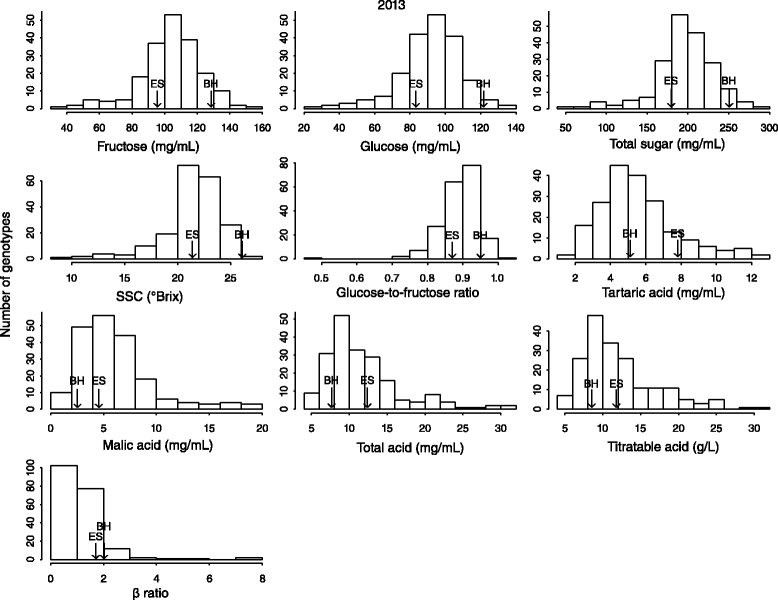Construction of a high-density genetic map and QTLs mapping for sugars and acids in grape berries
- PMID: 25644551
- PMCID: PMC4329212
- DOI: 10.1186/s12870-015-0428-2
Construction of a high-density genetic map and QTLs mapping for sugars and acids in grape berries
Abstract
Background: QTLs controlling individual sugars and acids (fructose, glucose, malic acid and tartaric acid) in grape berries have not yet been identified. The present study aimed to construct a high-density, high-quality genetic map of a winemaking grape cross with a complex parentage (V. vinifera × V. amurensis) × ((V. labrusca × V. riparia) × V. vinifera), using next-generation restriction site-associated DNA sequencing, and then to identify loci related to phenotypic variability over three years.
Results: In total, 1 826 SNP-based markers were developed. Of these, 621 markers were assembled into 19 linkage groups (LGs) for the maternal map, 696 for the paternal map, and 1 254 for the integrated map. Markers showed good linear agreement on most chromosomes between our genetic maps and the previously published V. vinifera reference sequence. However marker order was different in some chromosome regions, indicating both conservation and variation within the genome. Despite the identification of a range of QTLs controlling the traits of interest, these QTLs explained a relatively small percentage of the observed phenotypic variance. Although they exhibited a large degree of instability from year to year, QTLs were identified for all traits but tartaric acid and titratable acidity in the three years of the study; however only the QTLs for malic acid and β ratio (tartaric acid-to-malic acid ratio) were stable in two years. QTLs related to sugars were located within ten LGs (01, 02, 03, 04, 07, 09, 11, 14, 17, 18), and those related to acids within three LGs (06, 13, 18). Overlapping QTLs in LG14 were observed for fructose, glucose and total sugar. Malic acid, total acid and β ratio each had several QTLs in LG18, and malic acid also had a QTL in LG06. A set of 10 genes underlying these QTLs may be involved in determining the malic acid content of berries.
Conclusion: The genetic map constructed in this study is potentially a high-density, high-quality map, which could be used for QTL detection, genome comparison, and sequence assembly. It may also serve to broaden our understanding of the grape genome.
Figures

Similar articles
-
A dense SNP genetic map constructed using restriction site-associated DNA sequencing enables detection of QTLs controlling apple fruit quality.BMC Genomics. 2015 Oct 5;16:747. doi: 10.1186/s12864-015-1946-x. BMC Genomics. 2015. PMID: 26437648 Free PMC article.
-
QTL mapping for fruit quality in Citrus using DArTseq markers.BMC Genomics. 2017 Apr 12;18(1):289. doi: 10.1186/s12864-017-3629-2. BMC Genomics. 2017. PMID: 28403819 Free PMC article.
-
Construction of a high-density genetic map based on large-scale markers developed by specific length amplified fragment sequencing (SLAF-seq) and its application to QTL analysis for isoflavone content in Glycine max.BMC Genomics. 2014 Dec 10;15(1):1086. doi: 10.1186/1471-2164-15-1086. BMC Genomics. 2014. PMID: 25494922 Free PMC article.
-
Regulation of phytochemicals in fruits and berries by environmental variation-Sugars and organic acids.J Food Biochem. 2019 Jun;43(6):e12642. doi: 10.1111/jfbc.12642. Epub 2018 Aug 28. J Food Biochem. 2019. PMID: 31353611 Review.
-
Limitations and advantages of using metabolite-based genome-wide association studies: Focus on fruit quality traits.Plant Sci. 2023 Aug;333:111748. doi: 10.1016/j.plantsci.2023.111748. Epub 2023 May 23. Plant Sci. 2023. PMID: 37230189 Review.
Cited by
-
Changes and response mechanism of sugar and organic acids in fruits under water deficit stress.PeerJ. 2022 Aug 24;10:e13691. doi: 10.7717/peerj.13691. eCollection 2022. PeerJ. 2022. PMID: 36039369 Free PMC article. Review.
-
Genetic linkage map construction and QTL mapping of seedling height, basal diameter and crown width of Taxodium 'Zhongshanshan 302' × T. mucronatum.Springerplus. 2016 Jun 30;5(1):936. doi: 10.1186/s40064-016-2617-3. eCollection 2016. Springerplus. 2016. PMID: 27386380 Free PMC article.
-
Berry Anthocyanin, Acid, and Volatile Trait Analyses in a Grapevine-Interspecific F2 Population Using an Integrated GBS and rhAmpSeq Genetic Map.Plants (Basel). 2022 Mar 4;11(5):696. doi: 10.3390/plants11050696. Plants (Basel). 2022. PMID: 35270166 Free PMC article.
-
Identification of Selective Sweeps in the Domesticated Table and Wine Grape (Vitis vinifera L.).Front Plant Sci. 2020 May 14;11:572. doi: 10.3389/fpls.2020.00572. eCollection 2020. Front Plant Sci. 2020. PMID: 32477387 Free PMC article.
-
Vitis vinifera L. Fruit Diversity to Breed Varieties Anticipating Climate Changes.Front Plant Sci. 2018 May 1;9:455. doi: 10.3389/fpls.2018.00455. eCollection 2018. Front Plant Sci. 2018. PMID: 29765379 Free PMC article.
References
-
- Liu HF, Wu BH, Fan PG, Li SH, Li LS. Sugar and acid concentrations in 98 grape cultivars analyzed by principal component analysis. J Sci Food Agric. 2006;86:1526–1536. doi: 10.1002/jsfa.2541. - DOI
-
- Kliewer WM. Changes in concentration of glucose, fructose, and total soluble solids in flowers and berries of Vitis vinifera. Am J Enol Vitic. 1965;16:101–110.
-
- Shiraishi M. Three descriptors for sugars to evaluate grape germplasm. Euphytica. 1993;71:99–106. doi: 10.1007/BF00023472. - DOI
-
- Doty TE. Fructose sweetness: a new dimension. Cereal Foods World. 1976;21:62–63.
-
- Kulp K, Lorenz K, Stone M. Functionality of carbohydrates ingredients in bakery products. Food Technol. 1991;45:136–142.
Publication types
MeSH terms
Substances
LinkOut - more resources
Full Text Sources
Other Literature Sources

